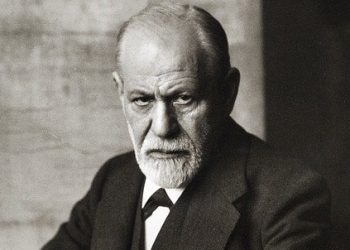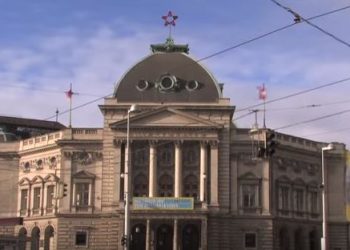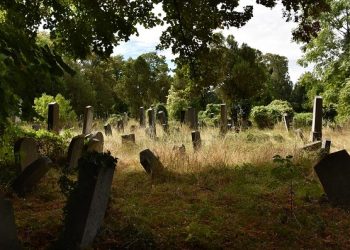The university’s buildings are scattered in about 60 locations throughout the city of Vienna. The main campus is located near the Ringstrasse, close to the City Hall, the Votivkirche (Votive Church), and the entrance to the old city area. You can enter the campus without any charge and wander among the ancient and elaborate buildings, but there are also guided tours available throughout the university.
If you are planning to tour Vienna’s Ringstrasse, it is worthwhile to visit the university and witness the beauty of the ancient building.
The Story of the University
The University of Vienna was founded on March 12, 1365, by Duke Rudolf IV (known as “the Founder”). The original name of the university was Alma Mater Rudolphina Vindobonensis, and it was established inspired by the University of Paris. The first university building opened in 1385, and after the Pope authorized its existence as a full university, it grew to become the largest university in the Holy Roman Empire with about 6,000 students.
In those years, universities were exclusive institutions, and those who were part of the academic institution were exempt from taxes and military service and also had a special dress code.
During the Reformation period, the prestige of the university, which was an institution under the patronage of the Pope, declined. Furthermore, the Ottoman siege in 1529, recurring plagues, and competition with other institutions led to a dramatic decrease in the number of students studying at the University of Vienna. King Ferdinand I tried to salvage the precarious situation and once again turned the institution into a stronghold of Catholic Christianity, giving priests control over religious studies at the university. This led to internal frictions that lasted for about 150 years.
In the 18th century, during the reign of Maria Theresa, the academic institution underwent a significant change, especially due to the limitation of the clergy’s power over it. Maria Theresa turned the university into a governmental body that was responsible for training public servants, physicists, biologists, and doctors, and fewer thinkers and humanists. In 1778, Protestant Christians were allowed to be admitted for studies, and about four years later, Jews could also be accepted into the university. In 1783, it was decided that the main language of instruction would be German.
In the mid-19th century, in 1848, a revolution expanded that also affected the university’s conduct and led to the freedom of research and research-based learning. This is an important change that is valid to this day and appears in the Austrian Universities Act.
In 1884, the main university building on the Ringstrasse was erected. The building was established by Emperor Franz Joseph I. The new university building was planned and designed in a style that symbolizes the flourishing period of universities in Italy. Despite the size of the new building, it never managed to accommodate all the departments and institutions of the university, so in 1915, several additional buildings were constructed nearby.
Interesting to Know
From the day the university was founded, for 532 years, women were not allowed to be admitted to academic studies. It was only in 1897 that the first woman, Elise Richter, was registered for language and literature studies.
During World War I, the university building served as a military hospital, and its halls were turned into dining and sleeping rooms, which greatly harmed the university’s growth as an academic institution.
During the rise of the Nazis and the annexation of Austria to the German Reich (the Anschluss), no less than 45 percent of the university’s senior professors and lecturers were dismissed from their positions for political or racist reasons.
Towards the end of the war, the university was bombed and hit by 26 bombs, and parts of it were destroyed. At the end of the war, in 1945, the university returned to normal activity despite extensive renovation work. In the following years, the university experienced rapid growth, especially thanks to the possibility of free education it offered.
The rapid growth of the university led to the construction of additional buildings and the transfer of faculties to other areas throughout the city of Vienna. Today, there are about 100,000 students studying in 15 different faculties in over 190 different courses. The university staff consists of about 9,500 employees.
University Buildings
The University of Vienna does not have a single campus and is spread over 60 locations throughout Vienna and also outside Vienna in the states of Lower Austria, Upper Austria, and Salzburg. Its main and historic building (which is worth seeing) is located on the Ringstrasse near the Schottentor underground station, the old City Hall, and the Votive Church. This is the building known to locals as “The University” (Die Uni). Most of the other important buildings of the university are located near the main building in the first and ninth districts of the city.
A few other important buildings worth mentioning: the campus in the old hospital, located two stops on tram 43 or 44 from the main university building. This is a large campus with a spacious central courtyard and many different faculties (the Faculty of Jewish Studies is located there, for example). Another place is the university’s Botanical Gardens, located in the third district, which can be visited freely, as well as the university’s observatory, located in the 18th district in the northern part of the city.
Guided Tour of the Main University Building
When you arrive at the main entrance of the university building, you can see the impressive structure with the words “Universitas Litterarum Vindobonensis” inscribed at the top. After entering the reception hall, you can see on the left all the people who were heads of the university and visit the various rooms of the university. You can do this accompanied by a guide from the university.
The guided tour presents the general history of the main building of the university. The tour passes through the ancient university rooms, including the reception hall, the main library room, the ceremonial hall, and more.
- Tour Duration: About one hour
- Operating Times: The English tour takes place on Saturdays (if there is no holiday on that day) and starts at 11:30 AM.
- On Thursdays at 6:00 PM, there is a tour in German, and also on Saturdays at 10:30 AM.
- Meeting Point: The reception hall in the main building at Universitätsring 1
- Tour Cost: €7 per participant
- There is no need to book tickets in advance. They can be purchased in the university’s entrance hall.
- Email for inquiries: fuehrungen@univie.ac.at
Independent Tour of the University
If you do not want to take a guided tour, you can take an independent tour of the complex using a dedicated application.
You can also rent an audio guide for €4 in the reception hall. In addition, you receive a brochure with all the stations included in the audio guide.
Essential Information for Visiting the University of Vienna
How to get to the historic university building?
The main building of the university is about a two-minute walk from the Schottentor underground station. The purple line, U2, stops there. The station is called Schottentor – Universität. After getting off the train, you need to go up the escalators and continue towards the shopping area in the station. After going up to the shopping area, you need to walk along the tram tracks towards the escalators that are on the far side (there is a pizza and shawarma stand nearby). After going up these stairs, you are right in front of the university building.
Another way to get there is by tram. There are many lines that reach the Schottentor station. The lines are: 37, 38, 41, 42, 43, 44, 1, 71, D. All stop at the station, and from there it is about a two-minute walk.
University Operating Hours:
The university is open every day except Sundays and holidays. It is open from the early morning hours (8:00 AM) until late at night (10:00 PM).
Address: Universitätsring 1


















